

By Eric Lindstrom

The R/V Revelle and the Lighter-Than-Air InfraRed System (on the left corner), as seen from the Surface Salinity Profiler. Credit: Dan Clark.
Kyla Drushka from University of Washington Applied Physics Laboratory (APL) received a National Science Foundation grant to participate in SPURS-2. It is one cornerstone of our work and is entitled “Rain-Formed Fresh Lenses in SPURS-2.” The idea of rainfall resulting in freshwater puddles or lenses at the sea surface is (perhaps) easy to imagine but is very tricky to observe and study in the real world. SPURS-2 will provide a wealth of new data on this subject with which to test the fidelity of our scientific imagination.
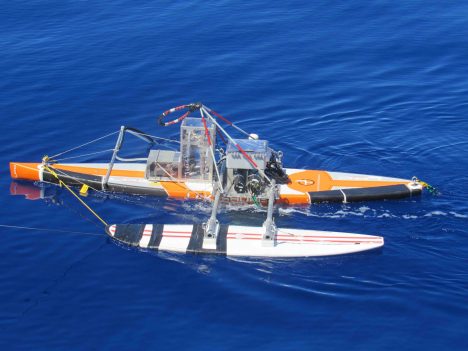
A beauty shot of the Surface Salinity Profiler.
Kyla and the APL crew have a variety of instruments aboard R/V Revelle but the Surface Salinity Profiler (SSP) is central to SPURS-2 science objectives. When you want to know the fate of rainwater after it hits the sea surface, measuring salinity (or equivalently the amount of freshwater) in the upper meter of the ocean is crucial. The profile of salinity in that top meter of the ocean is elusive for a number of reasons – technical and logistical. Technically, salinity sensors require some time and bubble-free water flow to make the measurement. However, normally the sea surface is rapidly moving up and down (because of waves!) so a sensor is not always in the water and away from bubbles until it is several meters below the surface. Finding a way to tow salinity (and other) sensors at fixed, shallow depths following the motions of the sea is another approach. APL scientists and engineers including Andy Jessup, Bill Asher, and Dan Clark designed the SSP to apply this approach.
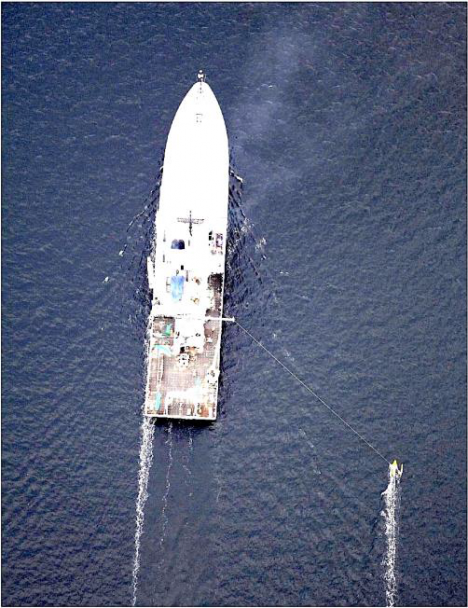
How the Surface Salinity Profiler runs outboard the ship — photo taken from the Lighter-Than-Air InfraRed System balloon camera.
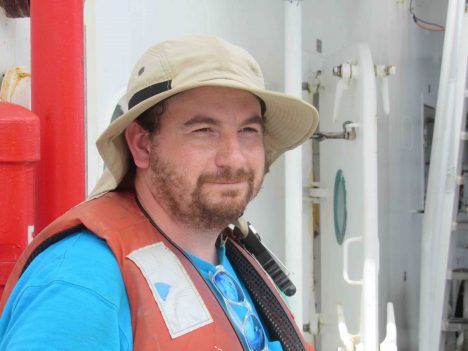
Dan Clark, APL engineer extraordinaire.
The SSP platform is a converted paddleboard with a keel and surfboard outrigger. It is tethered to the ship so it skims the sea surface outside the wake or influence of the ship. Below the paddleboard, on the leading edge of the keel, are salinity (and temperature) sensors at depths of 10 centimeters (4 inches), 30 centimeters (1 foot), 50 centimeters (1.64 feet), and 100 centimeters (3.28 feet), microstructure sensors (to estimate turbulence), and cameras. The Salinity Snake (see my last blog entry) supplements the SSP by providing temperature and salinity in the upper few centimeters of the ocean. The SSP can be towed for many hours before the instrument batteries need refreshing.
Deployment of SSP is most informative when there is a rain event, leading to stratification of the near-surface ocean with less dense fresher water on top of denser saltier water. If there is a rain event ahead of the ship, the SSP goes in the water. Then it can measure how the ocean changes over the periods from before rain, during rain, and recovering from rain. Salinity from several depths and simultaneous turbulence estimates are then used to determine how rainwater mixes into the ocean.
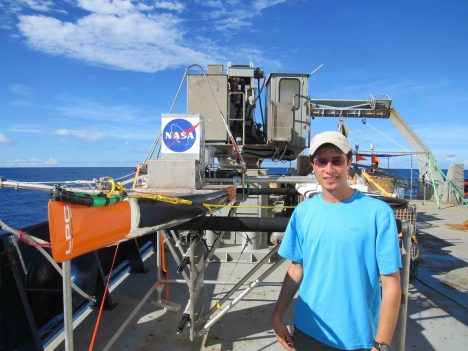
Suneil Iyer with Surface Salinity Profiler on deck (sensor to bottom left on keel)
Suneil Iyer is a new graduate student at University of Washington who will work with Kyla on interpretation of the microstructure measurements from the SSP data. He just arrived in Seattle from his hometown of Kansas City, Kansas, one week before the R/V Revelle departure from Honolulu. He just had time to find an apartment before jumping on a plane for SPURS-2. Graduate school in oceanography can be a blast of new experiences! This is not his first exposure to physical oceanography: Suneil worked on tides in estuaries during his undergraduate work at University of South Carolina.

Kyla Drushka working on the Surface Salinity Profiler.
Kyla Drushka joined UW in 2014 after PhD work at Scripps Institution of Oceanography. She is now an active member of NASA’s Ocean Salinity Science Team and the mission science team for the Surface Water Ocean Topography satellite that is planned for launch in April 2021.
This blog entry goes to press near an auspicious moment on R/V Revelle SPURS-2 voyage. Saturday at 2 am (local time) is the halfway point of our expedition! In our oceanography lexicon we would call this the “hump day” for our voyage. For all you land-loving 5-day-a-weekers hump day might mean Wednesday. For the 24/7 work at sea, we really have only a “hump moment” to mark the halfway point of a continuous work schedule. Like any good NASA activity, people aboard have countdowns running to both our hump moment and our arrival back in Honolulu (8 am on Sept. 23). Amusement is in short supply!
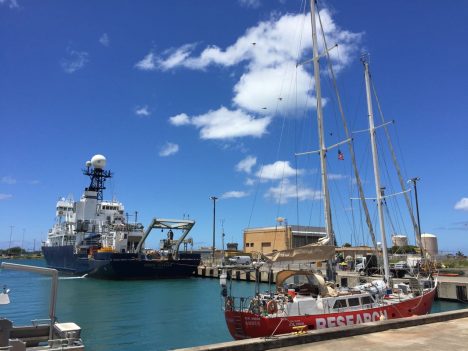
The Lady Amber and R/V Revelle in Honolulu.
By Eric Lindstrom
Two ships in Honolulu were abuzz with action this last week preparing for SPURS-2, a detailed study of ocean salinity in the eastern tropical Pacific Ocean. The Roger Revelle, upon which all the scientific party sails, had to be loaded with many tons of scientific equipment and installations completed all over the ship. Lady Amber, the 20-meter (66-feet) schooner, was also readied for action with the installation of meteorological and oceanographic gear.
It was amazing to see what was completed in only a week under the supervision of chief scientist Andy Jessup (University of Washington). Containers from Seattle, Woods Hole, and San Diego were unloaded and equipment hauled to the ships. Many scientists and technicians dedicated the entire week prior to Revelle’s departure on August 13 for stowage, assembly, installation, testing, and securing of instruments and gear. It was a very quiet ship over the last 24 hours after we departed as everyone had a well-deserved rest and acquired their sea legs!
The Lady Amber crew successfully tested its new installation of scientific gear but suffered a schedule setback when the crew discovered that the ship required a new engine prior to departure from Honolulu. These arrangements are underway and we are appreciative of the support provided by the University of Hawaii as the Lady Amber work gets completed. Lady Amber is expected to leave Honolulu in about a week and catch up with Revelle at the SPURS central work site, eight days southwest of Hawaii.

Argo the cat, relaxing in the Lady Amber.
Weather was fine on Saturday afternoon for Revelle departure. It was a quick trip out of the harbor with a great view of Waikiki skyline and Diamond Head. We passed by the Big Island of Hawaii on Sunday morning, August 14, giving people one last chance at cell phone calls. The island, really the largest mountain on our planet (from ocean bottom to summit), is a phenomenal sight.
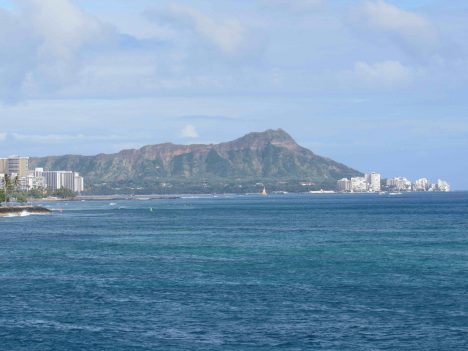
Goodbye to Honolulu!
On Sunday we had our first of weekly safety drills. Everyone got to learn how to decode the various horns that call for assembly, all clear, and abandon ship. We learned about survival suits and life raft deployment. Especially, we learned how to be safe on the Revelle and watch out for one another. We were encouraged to see the expert knowledge and conduct of the crew in their drills. It is over 2000 miles from Hawaii to the site where we begin work in earnest (deployment of moorings that pack the after deck). In the coming week, as we make the transit, the primary occupation will be testing and checking out various systems and training everyone for the complex operations to come. Once we are on site, we will quickly enter 24/7 scientific operations and we hopefully will have worked out all the glitches!
On a sad note, we had to leave our colleague Fred Bingham standing on the wharf in Honolulu, when we had expected him to sail with us. He was struck down with an illness that required he remain ashore and head home to Wilmington, North Carolina. His primary role in SPURS is as data manager. We are all assured that he will be on the mend very soon but we will miss his sunny manner and organizational skills.
The scientific party aboard Revelle is quite diverse – from first timers to old veterans. I’ll try to introduce you to the team in the weeks ahead. I am happy to report that I have seen no severe cases of seasickness during our initial day at sea. No doubt a few people are feeling a bit “green” but all are adapting well.
As always, I welcome your comments and suggestions for this blog. Send your messages to ejlindstrom@rv-revelle.ucsd.edu (case sensitive!). The expected frequency of the blog will be about one every two days.
By Eric Lindstrom
As I mentioned in my previous post, our cruise will depart from Woods Hole, MA on September 6. Roughly, it will take eight days for our ship, R/V Knorr, to transit from Woods Hole to the SPURS central mooring site at 25N, 38W, the saltiest spot in the subtropical North Atlantic. Then we will spend several days planning for and deploying sophisticated moorings bristling with instrumentation, which will remain in place for 12 months and provide a broader view of the mooring area’s physical properties, which will be our starting point for future, more localized ship-borne measurements. Details of moored instrumentation and how the approximately 5-kilometer (3-mile) long moorings are deployed will be the subject of my shipboard posts.
With moorings successfully in place, we will deploy an extensive array of Lagrangian (free-floating) instruments. There will be Argo floats that park at 1 km (0.6 mi) depth and periodically measure temperature and salinity measurements in the upper 2 km (1.2 mi) of the water column. We’ll also use surface drifters that measure surface temperature and salinity and the velocity of the upper ocean. We’ll deploy several kinds of gliders that collect upper ocean temperature and salinity data along pre-programmed tracks. There will also be specialized profilers for measuring the temperature and salinity fine structure to help us understand mixing processes. We will deploy and use these during the middle weeks of the expedition, while leaving many instruments that will continue to collect data for six months to a year.
Another aspect of the cruise is devoted to understanding the role of eddies (the swirls of ocean waters) in the circulation and the distribution of salinity. The cruise plan calls for finding and mapping an interesting front or eddy feature in some detail. My posts from the ship during that time will highlight the identification of the feature and how we chase it and measure it, and I will also describe the implications of our observations.
The expedition will wrap up with final checks of the instrumentation to be left behind, recovery of temporary deployments, profiles of temperature and salinity for cross-calibration of instruments and other duties that may arise.
We will use many of the kinds of instruments that are already deployed in a sustained, basin-wide observing system (surface drifters, Argo floats, moorings, and volunteer observing ships). What we will do with SPURS is expand the area we study, observe it for a longer time, and dig into the details. NOAA will be a strong partner throughout the SPURS mission, and I will tell you how we collaborate in future posts.
The chief scientist for the R/V Knorr leg of the SPURS experiment is Ray Schmitt from Woods Hole. Ray is funded by the National Science Foundation to examine salinity processes. NSF is an exceptional partner in SPURS – sharing the burden of ship support and helping to provide the scientists and equipment to study the smallest scales of variation of salinity. Their role is SPURS will also be detailed during the expedition posts.
All of the scientists and technicians involved in SPURS on R/V Knorr have numerous and specialized roles to play for the entire expedition to be successful. I plan on describing their personalities, work at sea, and motivations in future posts.
After approximately three weeks on site at the salinity maximum in the subtropical North Atlantic, R/V Knorr will make for Punta Delgada in the Azores Islands to turn over the ship to the next scientific party (not related to SPURS). It will take about 3 days at full speed to reach the Azores, where the ship is due on 9 October.
In my next post I will describe some of the shore-based and international collaborations that support SPURS.
Until then, smooth seas!